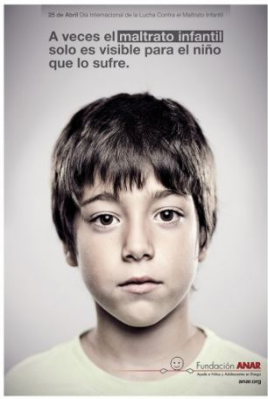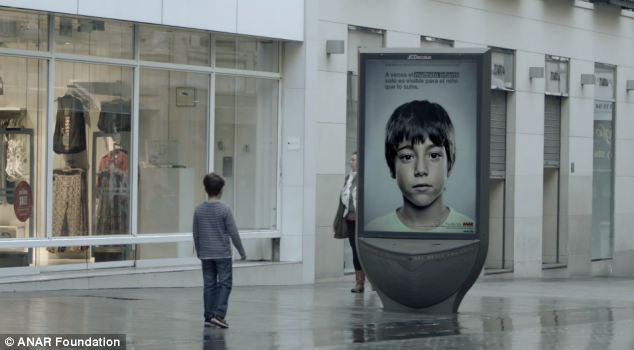
Children’s perspective

Adult’s Perspective
Image source: The anti-child abuse poster that can only be seen by children
This is a set of innovative adverts from the Spanish ANAR Foundation (Ayuda a Niños y Adolescentes en Riesgo) produced in 2013. The adverts use the bias of different heights of view to convey different messages to people:
To the eyes of a child under 135cm tall, the adverts show a call for help, ‘If you’re being abused, call XXX’, and show signs of injuries suffered by the child.
For adults, however, the advert looks like an ordinary poster and they do not receive a message with a way of asking for help, and they do not see elements that clearly show abuse.
This process of encoding and decoding takes on a deeper meaning by utilising innovative design and technological methods to deliver messages against abuse, while achieving specific communicative effects by exploiting the different perspectives of children and adults.
An important concept in cultural studies and communication, encoding and decoding in the media was originally proposed by British scholar Stuart Hall in his classic paper Encoding and Decoding (1973). This theory aims to explain the process of production, dissemination and reception of media messages, and it stresses that communication is not a unidirectional process, but a complex interactive behaviour.
Encoding is the process of producing content and Decoding is the process by which viewers receive and understand media messages. Encoders use carefully designed messages to convey specific meanings, and audiences decode the messages according to their own experiences, cultural backgrounds and ideologies.
The purpose of this design is to protect children from perpetrators such as their guardians who may find out about the messages the children are receiving.
In detail, the ads are unique in terms of encoding and decoding that adults are unable to see the messages, which protects the children from the abuser and ensures the safety of help-seeking. The core message of the adverts is, ‘If you’re being abused, you can safely ask for help.’ Put yourself in the position of a child and they fully understand the meaning of the advert and are getting an effective message.
This is the decoding that comes from seeing the advert from a different point of view. When we have God’s perspective and understand the message the advert is trying to convey, there are new and different interpretations:
- Some people see the advert as innovative and effective in protecting children.
- Some may recognise the technical design of the advert, but doubt its actual effectiveness, such as whether children will notice or be willing to ask for help.
- Another group may find the adverts too subtle and believe that the anti-abuse approach should be more direct, such as public education or legal disciplinary action.
However, this kind of creation is also an improvement of the coding process, ensuring that a specific message can only be interpreted by the target group. In the communication process, the coder gives multiple layers of meaning to the advert through technology and narrative design, and I think it gives us a possibility that the coding process is not only used to facilitate a better understanding by the audience, but can also be used to achieve a more meaningful purpose through technological innovation!
Resources:
The anti-child abuse poster that can only be seen by children
‘Encoding/decoding’ (2004) Stuart Hall, pp. 71–88. doi:10.4324/9780203496985-11.


This is a really good blog post. I really like the child abuse poster as an example to highlight how the encoding and decoding process works. You also mentioned how people might interpret the ad and its effectiveness, as it is supposed to target children, which might be a bit more difficult. I would say to improve the post, you could have briefly mentioned the dominant, oppositional and negotiated understanding of decoding media to link it to the ways people might interpret the ad.
Hi Boning! Overall, it is a great and effective post that lets people understand the Encoding/Decoding in the media by theorist Stuart Hall. I like you used this innovative child abuse ad as an example to ingenious and creatively explain the concept of Encoding and Decoding to let people who read this understand the basis of the theory – which is saying that people will “decode” the “codes” “encoded” by the media in different perspectives, just like the poster will have a different presentation to a small child compared to an adult. After that, you also effectively use three types of people’s interpretations that greatly match the theory’s “three hypothetical positions”: Dominant-hegemonic, negotiated, and oppositional, which is wonderful!
A little bit of suggestion: You mixed up the descriptions of the poster’s perspectives. It would also be better to give the sources or examples to demonstrate “Hamlet’s” interpretations and link them to the match positions so the reader will understand which position belongs to the interpretation.
I hope my suggestions can help, and good job!
This is a great post, very interesting example you chose to explain “the Diversity of Decoding and the Infinite Possibilities of Significance”. I found it very good the way you structured the post, for example the way you put two different photos of the same advert from the different perspective, the child vs the adult’s perspective. It will make it easy for the reader to really understand the different of the two. You also explained the purpose of the ad explaining how it relates to the topic, Encoding and Decoding.
A very interesting example. This advertisement gives itself a unique position by using special and highly recognizable coding. It utilizes the content it aims to promote to ensure it can be decoded in the way it desires—truly a wonderful design. I also noticed that you mentioned some people think this method might focus more on the creativity itself rather than the actual advertising effect. I don’t quite agree with that. Because it doesn’t truly make adults and children see fixed, different content, but rather uses this approach to make itself more attention-grabbing for the audience.